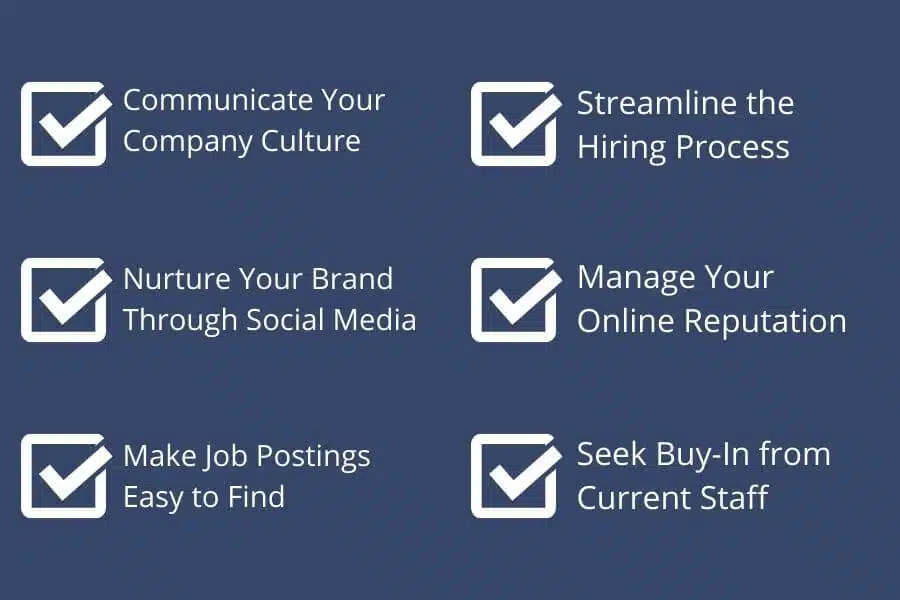
Labor shortages in the healthcare industry continue to make news headlines year after year, and we don’t expect to see this trend improve anytime soon. That said, the best way to be proactive with recruitment in its current state is to increase your appeal to candidates.
Healthcare marketing and advertising is generally directed at patients, but like patients, candidates are comparing your practice against competitors. When staffing is a top priority, your marketing strategy must consider the point of view of the healthcare professionals you seek.
What is e-Recruiting for Healthcare?
Ohio University defines e-recruiting as “the use of electronic resources to assist in the hiring process.”
One aspect of online healthcare recruitment is how professionals are likely to perceive your medical practice online. So, it’s important that you send a clear message about your values, and why prospective employees can expect a better-than-average experience.
What is Employer Brand and How It Is at the Core of Healthcare Recruitment Strategies?
Simply put, what a candidate knows about your practice is your employer brand. Your brand – as a whole – is how the public perceives your practice. While employer brand can be part of a general image, job seekers are the ones primarily concerned with it.
But keep in mind that your overall brand can influence candidates as well. So, when you communicate what’s exceptional about your practice, ideally this positioning should be as appealing to candidates as it is to patients. Great candidates want to provide excellent care, and showing how you provide excellent care can help sway their decision of where to apply.
Questions That Mold Recruitment Strategies in Healthcare
When there is a labor shortage, would-be employees have more room to be selective about which positions they apply for. Your medical practice brand is an asset that helps you stand out from other potential job opportunities they will choose from. Questions that can help you with your candidate attraction strategy include:
- Do my website and social media clearly articulate our mission and what we do for our patients? Is there enough content available to inform candidates about what it’s like to work here?
- Do my website, LinkedIn, and job listings clearly state the incentives that would make professionals want to apply?
- Does my social media inform candidates about our work culture and values? Do we spend enough time featuring and lauding our employees and culture on social media?
- What do current staff members have to say about their work experience? How can we communicate those positives to the public through online channels?
7 Stunning Stats on Employer Branding
Survey data strongly indicates that employer branding impacts target audience (candidates) decisions and helps employers connect with those who will be the best fit for the role. Here are some of the most convincing findings from LinkedIn and Glassdoor respectively.
- Lack of job description is the number one obstacle candidates experience when job hunting.
- 75% of candidates will consider the employer brand before they decide to apply.
- Hiring time is up to two times faster when an employer has a strong brand.
- Employer branding can reduce the new hire acquisition costs by 50% and attract 50% more qualified candidates.
- A negative reputation can raise hiring costs by almost 10% per new hire.
- 80% of Millennials (the generation with the most representation in the healthcare field) say they prioritize people and culture fit above career potential when choosing a workplace.
Failure to communicate your mission and values to potential candidates impacts the quality of care you deliver to patients because you must first attract the right employees to provide your standard of care.
What Candidates Look at Online
Survey data showed that 64% of job seekers look up the company after finding a job listing, and 37% won’t apply if information about the employer cannot be found. When a candidate finds out about a career opportunity with your practice, chances are good that they are looking at your website and social media pages.
Mostly, the company’s career page is where candidates go to learn about what an employer has to offer. So, it pays to have your medical website optimized for e-recruitment with everything a potential candidate needs to learn about your practice.
Successful E-Recruitment Action Steps
Consistency and clear messaging are essential to establishing your medical practice employer brand and attracting the right people for your team.
The clearer you are about what sets your practice apart, the more likely you are to stand out to employees and be a beacon for those who are the right fit for your practice. What do you have to offer that most in your market do not, and how can you communicate this in your online channels?
1. Communicate Your Company Culture
Communicating your medical practice culture is an essential part of healthcare recruitment strategy. Online channels (including your website and social media accounts) will broadcast your practice culture.
Candidates use information they find online to answer interview questions and ask questions of your recruiter in return. Ensuring that this information is readily available makes the interview process more efficient.
2. Showcase Your Work Environment
Featuring images and videos of a day-in-the-life working in your practice gives candidates an idea of what to expect. While minding patient privacy and heeding HIPAA laws, post photos or videos of the staff in action.
3. Nurture Your Employer Brand Through Social Media
From a quick scan of your popular social media pages, what impression would they gather about your practice? 68 % of talent acquisition experts consider professional networks to be one of the best tools to spread awareness about the employer brand. Moreover, new hires recruited through LinkedIn are 40% less likely to resign within the first six months of employment.
A social media presence can effectively affirm the following candidate-attraction factors:
- Patient satisfaction – reviews and engagement from your patients
- Employee appreciation – praising employees, highlighting achievements, and fun group photos
- Community involvement and compassion
Your account followers can also share job postings on their own feeds. So, consider leveraging your following to spread the word about open positions.
4. Make Job Postings Easy to Find and Streamline the Application Process
So, a candidate likes what they’ve seen and heard about your medical practice and is now eager to apply. How easy is it for them to find job listings on your website? For best visibility, have a careers page on your website dedicated to e-recruiting that includes all current openings while cross-posting these to other platforms (LinkedIn, Facebook, Glassdoor, Indeed, etc.).
Optimize your careers page for a candidate-friendly recruiting process. Make it easy to sort through job openings while minimizing steps in the application process.
5. Manage Your Online Reputation
Online reputation greatly influences a candidate’s decision to apply. Here are some stats that make this reality quite clear.
- 86% of job seekers refer to ratings and reviews to choose where to apply for a job.
- 67% of men and 86% of women avoid companies with bad reputations [Source: Glassdoor]
- 69% say they would not apply to companies with bad reviews even if they were unemployed [Source: Inc.com]
- 64% of consumers will avoid doing business with brands that are known to mistreat workers [Source: CareerArc]
- Job seekers will read at least six reviews before forming an opinion of an employer, and 7 out of ten would change their mind about a brand depending on the company’s public reply to a review [Source: Glassdoor]
Online reputation management is crucial to protecting your employer brand and serves a crucial role in healthcare recruitment strategies. Be proactive in monitoring platforms that capture employee feedback and ask current employees to leave an honest review.
6. Seek Buy-In from Current Staff
The whole staff can join the effort to recruit new faces. Offering employee incentives motivates your current staff to blast job postings through social media accounts or reach out to connections who would be interested in the position.
Current employees can also help with e-recruiting by being mindful about how they represent the practice on social media. Drafting an employee social media policy sets clear expectations about how the staff is expected to behave on online platforms. For example, don’t share privileged information about the practice, don’t be disparaging to co-workers or patients, include disclaimers about controversial topics, and more.
Cultivate an Online Presence that Attracts Talent with iHealthSpot
Patient care is negatively impacted by strained staff, or by hiring healthcare workers that are not a good fit. iHealthSpot helps you craft your brand image and messaging in a way that resonates with the staff your practice needs most










